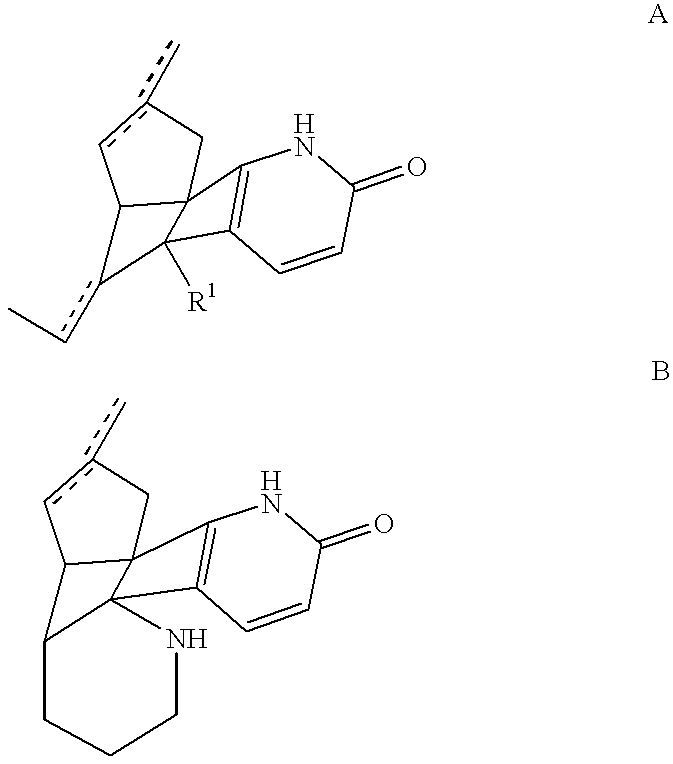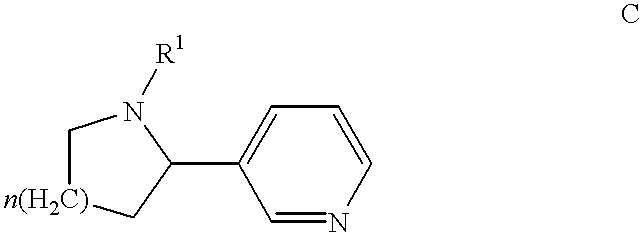Combination of huperzine and nicotinic compounds as a neuroprotective agent
a technology of nicotinic compounds and huperzine, which is applied in the field of combination of huperzine compounds and nicotinic compounds as neuroprotective agents, can solve the problems of homeostatic catastrophe flux, degeneration of central cholinergic system, and increased neuroprotective effect of huperzine a against glutamate, so as to prevent or reverse memory decline, effective dosage, and enhance memory
- Summary
- Abstract
- Description
- Claims
- Application Information
AI Technical Summary
Benefits of technology
Problems solved by technology
Method used
Image
Examples
example 1
6.1 Example 1
Neuroprotective Effect of (-)-Huperzine A Used Adjunctively with (-)-Nicotine Against NMDA-Induced Cell Toxicity
This Example demonstrates the increased neuroprotective effect of adjunctively administered (-)-huperzine A and (-)-nicotine, illustrative compounds of the invention, against NMDA-induced cell toxicity.
6.1.1 Experimental Protocol
In a first experiment, four samples each containing neuronal-glial cultures from mouse cerebral cortical cultures and a different concentration of (-)-nicotine (ranging from 0 to 100 .mu.M) were treated for 10 minutes with 75 .mu.M of NMDA (commercially available, for example, from Sigma Chemical Co., St. Louis, Mo.) to induce cell death. The cultures were prepared from 15-day-old fetal Swiss-Webster mice, as described in Bruno et al., 1998 Neuroscience 85:751-7 (hereinafter "Bruno et al."), incorporated herein by reference. Neuronal cells were plated in 96-well plates on a layer of confluent glial cells at a density of 200,000 cells / w...
example 2
6.2 Example 2
Neuroprotective Effect of (-)-Huperzine A Used Adjunctively with (-)-Nicotine Against .beta.-Amyloid-Peptide-Induced Cell Toxicity
This Example demonstrates the increased neuroprotective effect of adjunctively administered (-)-huperzine A and (-)-nicotine, illustrative compounds of the invention, against .beta.-amyloid-peptide-induced cell toxicity cell toxicity.
6.2.1 Experimental Protocol
In a first experiment, four samples each containing cultures of granule neurons prepared from mouse cerebellum and a different concentration of (-)-nicotine (ranging from 0 to 100 .mu.M) were treated for 48 hours with 25 .mu.M .beta.-amyloid peptide ("AP") (commercially available, for example, from Bachem, Inc., Torrance, Calif.) to induce cell death, according to the procedure described in Copani et al., 1995 Mol Pharmacol 47:890-7 (hereinafter "Copani et al.").
Then cell death was assessed by measuring the amount of LDH released into the medium according to the procedure described in B...
example 3
6.3. Example 3
Neuroprotective Effect of (-)-Huperzine A Used Adjunctively with (-)-Nicotine Against NMDA-induced Cell Toxicity
This Example demonstrates the synergistic neuroprotective effect of compositions of the invention against NMDA-induced cell toxicity relative to huperzine compounds alone or nicotine compounds alone, measured using an in vitro model. The synergistic effect was observed through the use of low concentrations of (-)-nicotine and (-)-huperzine A.
6.3.1 Experimental Protocol
In a first experiment, 5 samples each containing neuronal-glial cultures from mouse cerebral cortical cultures (prepared as described above in Section 6.1.1) and a different concentration of (-)-huperzine A (ranging from 0 to 1000 nM) were treated for 10 minutes with 100 .mu.M of NMDA to induce cell death, according to the procedure described in Bruno et al. Then the NMDA was removed and cell death was assessed for each sample by measuring the amount of LDH released into the medium according to ...
PUM
| Property | Measurement | Unit |
|---|---|---|
| Composition | aaaaa | aaaaa |
Abstract
Description
Claims
Application Information
 Login to View More
Login to View More - R&D
- Intellectual Property
- Life Sciences
- Materials
- Tech Scout
- Unparalleled Data Quality
- Higher Quality Content
- 60% Fewer Hallucinations
Browse by: Latest US Patents, China's latest patents, Technical Efficacy Thesaurus, Application Domain, Technology Topic, Popular Technical Reports.
© 2025 PatSnap. All rights reserved.Legal|Privacy policy|Modern Slavery Act Transparency Statement|Sitemap|About US| Contact US: help@patsnap.com



